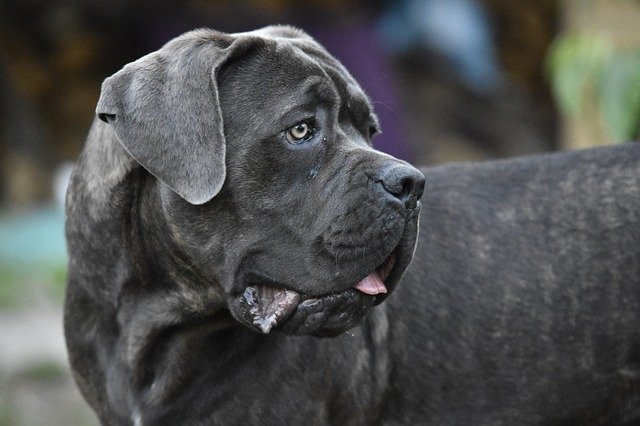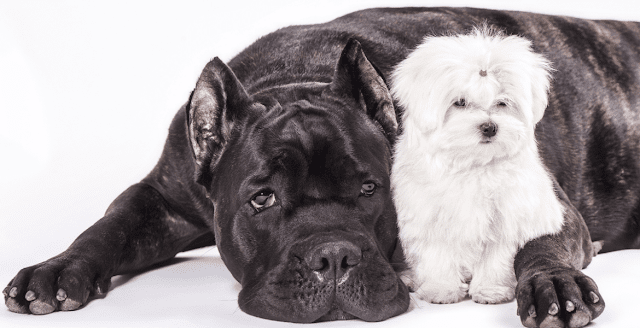White Cane Corso Also Known As Straw Italian Mastiff
Alluded to as "paglia," or the shade of straw, this shade of Corso is viewed as uncommon. Be that as it may, is it adequate in the show ring?
Standards are, by definition, about avoidance. As breeds advance and cement, they start to fix the noose of type.
Also, here and there, the composed standard turns into the request for execution for specific characteristics, regardless of whether it's a specific ear carriage or size or shading - generally something associated with one more variety that was presented in the establishment time frame. Years or many years after the fact, these cleansed qualities can reemerge, puzzling reproducers and provoking a few fanciers to inquire as to why they were prohibited in any case.
Enter the "straw" Cane Corso.
These cream-hued canines, which can have either dark or dim shade, are promoted as "uncommon" by certain reproducers, who charge as much as $5,000 for them. As this shading turns up unbidden and startling in whelping boxes - generally the aftereffect of a linebreeding - and consciousness of it expands, straw-hued Corsos have likewise shown up in the show ring lately - on this side of the Atlantic, at any rate.
Straw-shaded Cane Coro pup. The graciousness of Maxima Lux pet hotel, Serbia.
Maybe of course, there is a range of assessments on straw Cane Corsos among reproducers, with some keeping up with it is basically a super light shade of grovelling, and others contending that it is an unsatisfactory deviation from the norm.
Read more about Cane Corso cropped ears
What appears to be for the most part acknowledged is that the straw Corso isn't the aftereffect of some exceptionally ongoing cross, yet rather is a return to a recorded shading potentially coming about because of crossbreeding with the Maremma or Abruzzese Sheepdog, Italy's solution to the Kuvasz of Hungary or the Great Pyrenees of France. Whatever its provenance, this light-shaded Cane Corso - called the stick da pagliaio, and that implies the "straw-stack canine" - was supposed to be valued among the ranchers of Italy's meridional.
Head investigation of a thoroughbred Maremma Sheepdog, likewise alluded to as the Maremmano or Abruzzese Sheepdog, which is accepted to give the straw Cane Corso its unmistakable shading.
The aftereffect of a Cane Corso/Maremma cross, 1980s. These canines were now and again called mezzo, or "half," Corso. Photograph politeness Shauna DeMoss.
"The straw stack was a practical unit of the homestead in that, during winter, it functioned as the haven of all creatures, felines and canines included," composed Dr. Flavio Bruno in Il Cane Corso, his 1994 book on the variety. "The favored shade of this canine was straw-like since elderly folks individuals imagined that the personality of a straw-hued canine was 'combustible' like the straw."
Today, nonetheless, straw isn't referenced in any of the world's Cane Corso norms, all of which settle on the satisfactory current tones: dark; all shades of dim; all shades of groveling (which can likewise show up in a weaken rendition, called formentino among fanciers), and red. The spot design is allowed on this multitude of tones, however clearly on dark canines, the stripes are not apparent. Also, the AKC standard notes that strong grovel and red canines have a cover that is dark in grovel canines and dim in formentino canines. (Since formentini are weakening, they are hereditarily unequipped for creating dark color.)
The main excluding shading in the AKC standard is for tan places, as generally found in Rottweilers or Dobermans. There is no preclusion for a shading not in any case portrayed in the norm.
In a post on the Cane Corso Association of America site composed by Robyn Salisbury, straw is explicitly referenced among "non-standard" coat tones, for example, chocolate, liver, and Isabella grovel (weaken liver), portraying it as "a light yellow or cream tone with no cover and the nose is most frequently a blurred earthy colored tone or dark."
However they are now and then advertised as "white" Cane Corsos, the straw canines are not unadulterated white. Subsequently, they don't have any of medical problems, like deafness, regularly connected with albinism, or absence of shade.
Straw Cane Corsos might seem white, yet they are not. Their genuine nature is promptly clear against a background of snow. Photograph politeness Lynn Herring.
Regardless, "as I would see it, I believe it's precise to say straw is a dubious shading," says regarded Cane Corso judge Massimo Inzoli of Sicily, who doesn't believe straw to be genuine grovel. "The tone existed in the variety, very much like the melogna, or badger tone, which comes from the Neapolitan Mastiff. Now and then, some latent quality can turn up: I recollect the discussion in Brazil over a chocolate-shaded Cane Corso that was entered in the hero class!"
A few years prior, when Marcos Reta of Campione Cane Corsos in Miami reared a litter out of two spot guardians, he was astounded to observe that few of the nine little dogs were straw-hued. Instead of speculating about their hereditary cosmetics, he presented a DNA test to a hereditary qualities research facility.
The outcome? The pups were homozygous for the "e" transformation, which stifles dark shade in the coat and just takes into consideration the creation yellow color. As such, the little dogs were not hereditarily grovelled, yet rather had similar shading hereditary qualities as a yellow Labrador Retriever. (In different varieties, like the Irish Setter, the "e/e" genotype communicates in an unexpected way, delivering a red coat tone.)
DNA results on straw-shaded Cane Corso. Despite the fact that the canine is "sable/grovel" at the A locus, the "yellow/red" change at the E locus takes out and supersedes some other coat shading that might be hereditarily present. Canines of this "e/e" genotype can't have a cover, as this report shows. Graciousness Marcos Reta.
To be yellow, or straw, a Corso should have two duplicates of this passive quality. Canines with just one duplicate won't be straw, however as transporters they can deliver the shading whenever reproduced to another standard-hued canine that conveys it.
Reta put every one of the pups as pets however for one's purposes, a bitch he kept and has since reproduced; she didn't deliver any straw pups, however, all the posterity are transporters and could create straw whenever reared to different transporters.
While Reta says he doesn't raise for shading, he's baffled that straw Corsos would be an issue in a variety that got going with such a different range. "The Corso is reproduced from such countless different varieties, why to exclude a canine that has been essential for it for many years?" he asks logically.
"The straw tone was exceptionally esteemed before the standard was composed," concurs Zeljko Tasic of Maxima Lux Kennel in Belgrade, Serbia. "Those canines had brilliant prey drive, and from my experience that is right. Furthermore, I should make reference to that all of the 10 to 12 straw little guys I have created are very typey, with lovely heads."
Straw Cane Corso (front line) contrasted with a typically shaded formentino, or grovel weaken. Photograph civility Lynn Herring.
Not all raisers who produce straw feel the same way. Slobodan Grujic of Kennel Spunk Gang in Vojka, Serbia, who startlingly created straw little dogs around five years prior, says he doesn't show or purposefully breed the shading since he doesn't believe it to be in norm.
"It notable tones are satisfactory as indicated by the norm, and each light-hued canine must have a dark or dim veil on the gag," he clarifies. "It's exceptionally uncommon that you have the straw tone with a dark cover, and there are more straw canines without the veil. They can't be displayed as they don't have the necessary dark cover or shading on the gag."
To be sure, any Internet look for straw-shaded Corsos will yield photos of canines with one or the other dark or dim noses that might have shading on the facade of their gags, however don't have a total cover.
Also that is on the grounds that they can't.
Dr. Sheila M. Schmutz, a teacher at the University of Saskatchewan in Saskatoon, Canada, who has practical experience in canine coat tones, takes note of that it is hereditarily unimaginable for a canine of any variety with the e/e genotype to have a cover. While she takes note of that genuine grovel canines don't dependably have covers, "rosy e/e canines never have a solitary dark hair on them - not so much as a bristle."
Light grovel Bullmastiff. Note the dark on the gag (this much concealing would be wrong for a Corso, as it ought to never go up over the eyes), ears, and bibbling.
Schmutz stresses that this shortfall of dark applies just to the hide: Dogs that are e/e can have dark shade (or dim, assuming they are formentini) on their noses, lips, and skin. For sure, in straw canines, shading on the gag gets from the skin or mucous films, not simply the hide, which is the reason it is normally present on the facade of the gag yet not on the sides. What's more it is reasonable this shortfall of dark hide that makes fanciers do a twofold take: While a genuine grovel Bullmastiff, for instance, can be a light bread roll tone as to be nearly pretty much as fair as many straw Corsos, the presence of complete dark on the ears and gag, and frequently grizzling on the neck, give it an altogether different visual impression.
Judges who are befuddled with regards to whether they have a straw Cane Corso in the ring can't, nonetheless, simply accept that they can recognize the shading in light of the shortfall of a veil. As Dr. Schmutz brings up, genuine grovels can likewise need veiling. Furthermore albeit the many Cane Corso judges, especially in Europe, are not leaned to highlight grovel or red canines that need concealing, that issue is ostensibly undeniably less genuine than an out-of-standard tone.
So how does an honest reproducer, purchaser or judge differentiate?
Recognizing a straw coat might boil down to Supreme Court Justice Potter Stewart's popular meaning of bad-to-the-bone erotic entertainment: I know it when I see it. For anybody acquainted with the variety, the straw coat's impossible to miss cast is apparent, however even experienced reproducers experience issues adequately articulating what they consider a clearly inaccurate coat tone.
"It's extremely difficult to depict," concurs Zoe DeVita of Italica Terrae Cane Corsos in Westchester County, New York, who has delivered two straw doggies in a linebree




Cane Corsos are powerful and athletic, best suited to experienced pet parents who have large, securely fenced yards. They’ll definitely need their humans to give them a task; otherwise, they may find their own ways to reduce boredom — probably with destructive behavior. If you can give your dog plenty of space, exercise, and training, then this may be the breed for you!
ReplyDelete